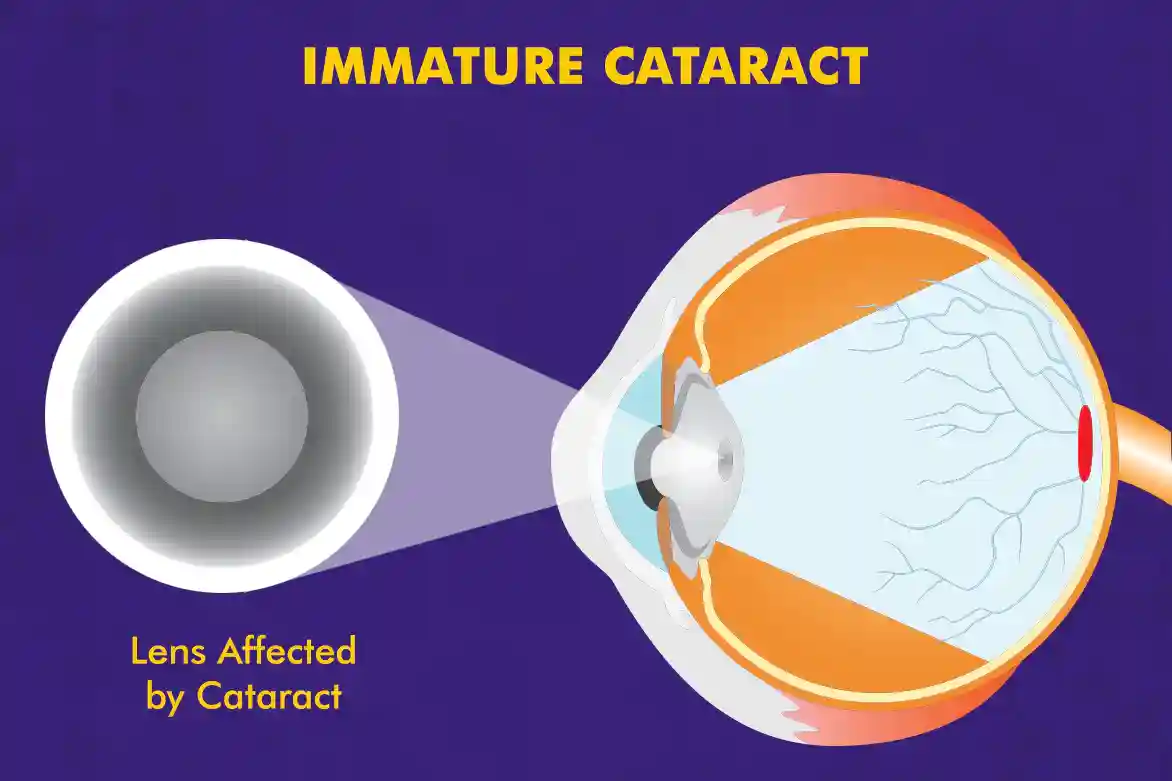An immature cataract is an early-stage cataract where the lens of the eye has started to become cloudy but retains some degree of transparency. It is a progressive condition that, if left untreated, can develop into a mature cataract, leading to significant visual impairment. Early intervention can help manage symptoms and delay progression.
Cataracts are one of the leading causes of vision loss worldwide, particularly in older adults. Understanding the early signs and treatment options can significantly improve the quality of life for those affected. By identifying and addressing the symptoms early, individuals can take preventive steps to slow down cataract progression.
Immature Cataract Definition
An immature cataract refers to a partially developed cataract, with only a portion of the lens becoming opaque. The remaining part of the lens remains transparent, allowing some light to pass through. This stage precedes the mature cataract phase, where the entire lens becomes completely opaque, resulting in severe vision loss.
Unlike a mature cataract, an immature cataract still permits some degree of vision, though clarity is affected. At this stage, corrective measures like glasses and lifestyle adjustments may still help manage the condition. However, as the cataract progresses, vision impairment worsens, necessitating medical intervention.
Learn the difference between mature vs immature cataract.
Immature Cataract Causes
Several factors contribute to the development of an immature cataract, including:
- Aging – The natural agieng process leads to protein breakdown in the lens, causing cloudiness. This is the most common cause of cataracts.
- Genetics – A family history of cataracts increases the risk of early onset. Genetic predisposition can influence the rate at which cataracts develop.
- Diabetes – High blood sugar levels can lead to early cataract formation due to sugar deposits in the lens, causing clouding.
- Prolonged UV Exposure – Continuous exposure to ultraviolet rays accelerates oxidative stress in the eye, damaging lens proteins. UV-protective eyewear can help reduce this risk.
- Eye Trauma – A direct injury to the eye may disrupt the structure of the lens, leading to cataract formation. This can occur due to accidents, surgeries, or blunt force trauma.
- Certain Medications – Long-term steroid use, either oral or topical, is associated with an increased risk of cataract formation.
- Nutritional Deficiencies – A diet lacking essential nutrients like vitamins C and E, and antioxidants can contribute to cataract progression. Foods rich in omega-3 fatty acids and carotenoids can support eye health.
- Smoking and Alcohol Consumption – These habits are linked to oxidative stress and inflammation, which accelerate lens degeneration.
Risk Factors for Immature Cataract
Some individuals are more prone to developing immature cataract due to:
- Chronic medical conditions such as hypertension and obesity, which affect eye health.
- Frequent exposure to artificial blue light, leading to eye strain and fatigue.
- Long-term use of corticosteroids, which can induce cataract formation as a side effect.
- Frequent dehydration affects the lens’s ability to maintain transparency and flexibility.
By recognizing these risk factors early, individuals can take preventive measures, such as wearing protective glasses, following a nutrient-rich diet, and managing underlying medical conditions.
Stages of Immature Cataract
Immature cataracts progress through the following stages:
- Initial Stage: Mild clouding of the lens with little to no noticeable visual impairment.
- Early Progression: The cloudiness starts affecting vision, causing slight blurriness and difficulty with contrast.
- Mid-Stage Immature Cataract: Lens opacity increases, leading to noticeable vision disturbances and difficulty seeing in low light.
- Advanced Immature Cataract: The clouding extends, significantly impairing vision and making daily activities challenging.
- Mature Cataract Formation: The entire lens becomes opaque, requiring surgical intervention.
Immature Cataract Symptoms
The symptoms of an immature cataract vary based on the extent of lens opacity. Common signs include:
- Gradual blurriness or clouded vision making objects appear hazy.
- Increased sensitivity to bright lights and glare.
- Difficulty seeing in dim lighting or at night.
- Faded or yellowed colors, reducing vibrancy in vision.
- Frequent changes in eyeglass prescription as the cataract worsens.
- The presence of an iris shadow in immature cataract, where a shadow is cast on the iris due to lens opacity.
- Halos around lights, especially at night, making driving difficult.
- Difficulty focusing on fine details, such as small text or intricate designs.
Iris Shadow in Immature Cataract
One of the key indicators of an immature cataract is the presence of an iris shadow in immature cataract. This occurs due to the partial opacity of the lens, which causes light to be unevenly refracted, resulting in a shadow on the iris. This symptom is often detected during an eye examination and serves as an important sign of early cataract development.
How Immature Cataract Affects Vision
As cataracts progress, vision changes include:
- Loss of Contrast Sensitivity – Difficulty distinguishing objects in poor lighting.
- Double Vision in One Eye – Caused by irregular light refraction.
- Color Perception Changes – Colors appear less vibrant, dull, or yellowed.
- Increased Eye Strain – Struggles in performing close-up tasks like reading or sewing.
Conclusion
An immature cataract requires early diagnosis and proactive management. Understanding its progression and treatment ensures better long-term eye health. Early lifestyle modifications, regular eye exams, and medical consultations can significantly improve outcomes and delay the need for surgery.
Take charge of your vision today and prevent further cataract progression. Schedule an Eye Checkup Now!
FAQs
Can immature cataracts progress to a more advanced stage?
Yes, if left untreated, it can progress to a more advanced stage over time.
Are there preventive measures to delay the progression of immature cataracts?
Yes, wearing sunglasses, maintaining a healthy diet, and avoiding smoking can help delay its progression.
Can immature cataracts be managed without surgery?
While lifestyle changes and prescription updates may help manage its symptoms, surgical intervention is often necessary for significant improvement.
Are there any lifestyle changes that can reduce the risk of immature cataracts?
Yes, adopting a healthy lifestyle, including a balanced diet, UV protection, and not smoking or drinking alcohol, can reduce the risk of developing it.
Is surgery the only solution for immature cataracts?
Surgery is the most effective and common solution for it, providing significant vision improvement.
How much does treating immature cataracts cost?
The cost varies based on factors like the type of surgery, choice of IOL lens, surgeon’s experience, procedure complexity, and geographical location. It’s advisable to consult with healthcare providers for specific cost estimates.
Is it safe to remove immature cataract?
Yes, it is generally safe to remove an immature cataract if it significantly impairs vision.
What is a premature cataract?
A premature cataract refers to the development of cataracts at an earlier age than usual.
What are the 4 stages of cataract?
The four stages of cataract development are early, immature, mature, and hypermature.
How do you treat immature senile cataracts?
Early cataracts can be managed with prescription glasses but as they advance, surgery is recommended.
What is an immature cataract?
An immature cataract is a partially developed cataract where only a portion of the lens becomes cloudy while the rest remains transparent. It allows some light to pass through, causing gradual vision impairment rather than complete blindness.
What are the early signs of an immature cataract?
Early signs include blurry vision, increased sensitivity to light and glare, difficulty seeing in dim lighting, faded colors, and the appearance of an iris shadow in immature cataract, which may indicate lens opacity.
Can an immature cataract be treated without surgery?
In the early stages, vision can be managed with eyeglasses, lifestyle adjustments, and dietary changes. However, as the cataract progresses, surgery becomes the only effective treatment option.
What causes an immature cataract to progress to a mature cataract?
Factors such as aging, uncontrolled diabetes, prolonged UV exposure, smoking, and nutritional deficiencies can accelerate cataract progression, leading to full lens opacity and severe vision impairment.
When should I see a doctor for an immature cataract?
You should see a doctor if you experience frequent changes in vision, difficulty performing daily tasks, halos around lights, or increased trouble seeing in low light. Early diagnosis can help in managing symptoms effectively.





